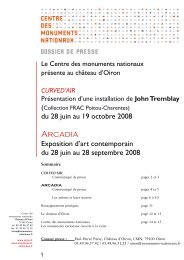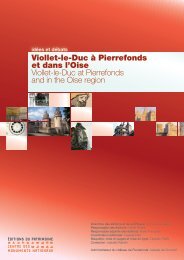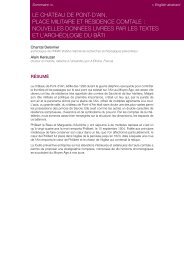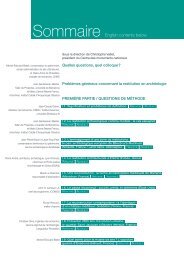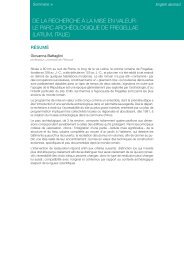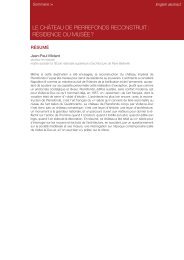Les vitraux de Brou et le mécénat de Marguerite d'Autriche dans le ...
Les vitraux de Brou et le mécénat de Marguerite d'Autriche dans le ...
Les vitraux de Brou et le mécénat de Marguerite d'Autriche dans le ...
You also want an ePaper? Increase the reach of your titles
YUMPU automatically turns print PDFs into web optimized ePapers that Google loves.
<strong>Les</strong> <strong>vitraux</strong> <strong>de</strong> <strong>Brou</strong><br />
<strong>et</strong> <strong>le</strong> mécénat <strong>de</strong> <strong>Marguerite</strong> d’Autriche<br />
<strong>dans</strong> <strong>le</strong> domaine du vitrail<br />
Yv<strong>et</strong>te Van<strong>de</strong>n Bem<strong>de</strong>n<br />
Venons-en à présent aux <strong>vitraux</strong> <strong>de</strong> <strong>Brou</strong> ou, plus<br />
précisément, à ceux qui concernent directement<br />
<strong>Marguerite</strong> d’Autriche, <strong>dans</strong> <strong>le</strong> chœur <strong>et</strong> <strong>dans</strong> sa<br />
chapel<strong>le</strong>.<br />
Nous savons 9 que <strong>de</strong>s patrons <strong>et</strong> <strong>de</strong>s plombs<br />
furent envoyés <strong>de</strong> Bruxel<strong>le</strong>s en 1525 <strong>et</strong> qu’on travail<strong>le</strong><br />
au placement <strong>de</strong>s verrières <strong>de</strong> <strong>Marguerite</strong> à<br />
<strong>Brou</strong> <strong>de</strong> 1526 à 1528 surtout. On connaît éga<strong>le</strong>ment<br />
<strong>le</strong>s verriers Jean Brachon, Jean Orquois <strong>et</strong> Antoine<br />
Noisin. En 1539, <strong>le</strong>s verrières sont fort détériorées<br />
par une grê<strong>le</strong> <strong>et</strong>, en 1547, par <strong>le</strong>s soldats du roi <strong>de</strong><br />
France ; <strong>de</strong>s restaurations se suivent jusqu’à Émi<strong>le</strong><br />
Hirsch, qui intervient – <strong>de</strong> façon plus importante –<br />
à partir <strong>de</strong> 1884 <strong>dans</strong> <strong>le</strong> cadre <strong>de</strong> la restauration<br />
généra<strong>le</strong> ; d’autres ont encore lieu au xx e sièc<strong>le</strong>.<br />
Avant d’al<strong>le</strong>r plus loin, il faut signa<strong>le</strong>r qu’une sérieuse<br />
critique d’authenticité – qui, à notre connaissance,<br />
n’a pas encore été publiée – s’impose avant que<br />
l’on puisse porter <strong>de</strong>s jugements définitifs sur ces<br />
œuvres, manifestement fort restaurées.<br />
Ces verrières se signa<strong>le</strong>nt surtout, techniquement,<br />
par <strong>de</strong> nombreux verres doublés <strong>et</strong> gravés, <strong>de</strong>s<br />
pièces insérées en chefs-d’œuvre – pour <strong>le</strong>s écus<br />
armoriés par exemp<strong>le</strong> –, <strong>et</strong> <strong>de</strong>s damas d’une variété<br />
<strong>et</strong> d’une richesse remarquab<strong>le</strong>s.<br />
L’iconographie <strong>de</strong>s verrières <strong>de</strong> <strong>Brou</strong> a été maintes<br />
fois commentée. <strong>Les</strong> fenêtres centra<strong>le</strong>s du chœur<br />
sont conçues comme un triptyque : <strong>de</strong>ux scènes<br />
d’Apparition au centre (ill. 5a <strong>et</strong> b) ; <strong>le</strong> coup<strong>le</strong> ducal,<br />
<strong>le</strong>s saints patrons <strong>et</strong> <strong>de</strong>s écus armoriés sur <strong>le</strong>s<br />
« vol<strong>et</strong>s » (ill. 6a <strong>et</strong> b, 7). La Crucifixion centra<strong>le</strong><br />
habituel<strong>le</strong> est remplacée par l’Apparition du Christ<br />
à la Vierge <strong>et</strong> à Marie Ma<strong>de</strong><strong>le</strong>ine, thèmes <strong>de</strong> résurrection<br />
<strong>et</strong> non <strong>de</strong> mort. Le r<strong>et</strong>ab<strong>le</strong> qui <strong>de</strong>vait prendre<br />
place <strong>dans</strong> l’absi<strong>de</strong> était consacré à la Crucifixion<br />
<strong>et</strong> <strong>le</strong>s épiso<strong>de</strong>s représentés formaient donc un<br />
tout avec <strong>le</strong>s peintures sur verre ; <strong>de</strong>s allusions à<br />
la Passion existent éga<strong>le</strong>ment, discrètement, <strong>dans</strong><br />
<strong>le</strong> vitrail central.<br />
5b<br />
5a<br />
5. <strong>Brou</strong>, église Saint-Nicolas-<strong>de</strong>-To<strong>le</strong>ntino, vitrail central <strong>de</strong> l’absi<strong>de</strong>,<br />
Apparition du Christ à Marie Ma<strong>de</strong><strong>le</strong>ine (registre supérieur, 5a)<br />
<strong>et</strong> Apparition du Christ à la Vierge (registre inférieur, 5b), 1526. Cliché M. Damien.<br />
9. Voir l’abondante bibliographie sur <strong>le</strong>s <strong>vitraux</strong> <strong>de</strong> <strong>Brou</strong> <strong>et</strong> entre autres : manuscrit du père Raphaël <strong>de</strong> la Vierge Marie, prieur du<br />
monastère <strong>de</strong> <strong>Brou</strong>, Description historique <strong>de</strong> la bel<strong>le</strong> église <strong>et</strong> du couvent royal <strong>de</strong> <strong>Brou</strong>, tirée <strong>de</strong> <strong>le</strong>urs archives <strong>et</strong> <strong>de</strong>s meil<strong>le</strong>urs<br />
historiens qui en ont écrit, par ***, transcription par Marie-Françoise Poir<strong>et</strong> ; Françoise Baudson, « Le vitrail », Visages <strong>de</strong> l’Ain, n o 3,<br />
1948, p. 10-18 ; Victor No<strong>de</strong>t, « Un vitrail <strong>de</strong> l’église <strong>de</strong> <strong>Brou</strong>. Titien <strong>et</strong> Albert Dürer », Gaz<strong>et</strong>te <strong>de</strong>s beaux-arts, 35, 1906, p. 95-112 ;<br />
Victor No<strong>de</strong>t, « IV. Église <strong>de</strong> <strong>Brou</strong> », in Lucien Bégu<strong>le</strong>, <strong>Les</strong> Vitraux du Moyen Âge <strong>et</strong> <strong>de</strong> la Renaissance <strong>dans</strong> la région lyonnaise <strong>et</strong><br />
spécia<strong>le</strong>ment <strong>dans</strong> l’ancien diocèse <strong>de</strong> Lyon, Lyon, 1911, p. 165-199 ; M. D. Nivière, « Fenêtres <strong>et</strong> <strong>vitraux</strong> », <strong>Brou</strong>. Histoire du site, <strong>le</strong> chantier<br />
<strong>de</strong> construction au xvi e sièc<strong>le</strong>, cat. exp., Bourg-en-Bresse, musée <strong>de</strong> l’Ain, 1980, p. 49-52 ; Marie-Françoise Poir<strong>et</strong>, Le Monastère<br />
<strong>de</strong> <strong>Brou</strong>. Le chef-d’œuvre d’une fil<strong>le</strong> d’empereur, Paris, Caisse <strong>de</strong>s monuments historiques <strong>et</strong> <strong>de</strong>s sites, 1994 ; Marie-Anne Sarda<br />
<strong>et</strong> Magali Philippe, Le Monastère royal <strong>de</strong> <strong>Brou</strong>. Bourg-en-Bresse, Paris, Éditions du patrimoine, 2005, spécia<strong>le</strong>ment p. 37-47.


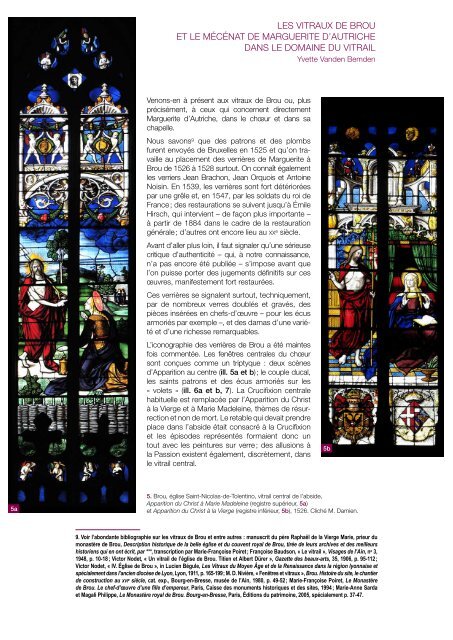
![I a @aj pna `ao i k j q i aj po j ] pek j ] q t l nųoaj pa ] q _d Špa] q `a I ...](https://img.yumpu.com/26991655/1/184x260/i-a-aj-pna-ao-i-k-j-q-i-aj-po-j-pek-j-q-t-l-naoaj-pa-q-d-a-pa-q-a-i-.jpg?quality=85)

![I a @ aj pna ` ao i k j q i aj po j ]pek j ]q t lnùoaj pa au château de ...](https://img.yumpu.com/26991649/1/184x260/i-a-aj-pna-ao-i-k-j-q-i-aj-po-j-pek-j-q-t-lnaoaj-pa-au-chateau-de-.jpg?quality=85)
